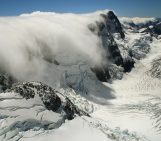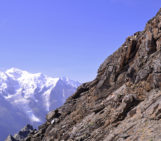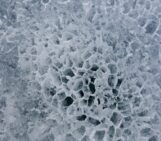
In 2012 I had the opportunity to help lead a teaching excursion to the Norwegian archipelago Svalbard. On this trip, geography students from the Ruhr-University of Bochum in Germany had the chance to learn more about the nature of this fascinating island.
In addition to Svalbard’s climatology and the wildlife, the region’s glaciology and geomorphology were the main topics we focused on. For example, we walked to the glacier ice, measured the glacier drainage flow and assigned various glacial debris accumulations (also known as moraines) to their genesis. Furthermore, PhD students from the local university showed us field experiments on how the region’s permafrost melts and wet soils slide downhill (also known as solifluction). We could see the giant glacier tongues with ice fronts at the sea level on a boat trip to the old coal mining town of Longyearbyen. The debris cover and the incredibly large medial moraine (debris that collects when two glaciers merge together) of the pictured glacier particularly impressed us.
We were astonished when the two polar bears came into sight after a short moment. Of course, we had secretly hoped to see polar bears on this excursion, but when it actually happened, not only the glaciers and the whole landscape seemed bigger, but also the wild nature of Svalbard got much more impressive. For me, my colleague André and my students this experience will be unforgettable.
By A. Martina Grudzielanek, Ruhr-University of Bochum, Germany
Imaggeo is the EGU’s online open access geosciences image repository. All geoscientists (and others) can submit their photographs and videos to this repository and, since it is open access, these images can be used for free by scientists for their presentations or publications, by educators and the general public, and some images can even be used freely for commercial purposes. Photographers also retain full rights of use, as Imaggeo images are licensed and distributed by the EGU under a Creative Commons licence. Submit your photos at http://imaggeo.egu.eu/upload/.




